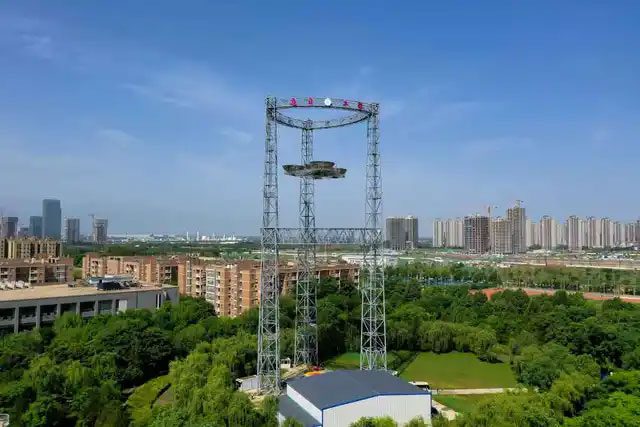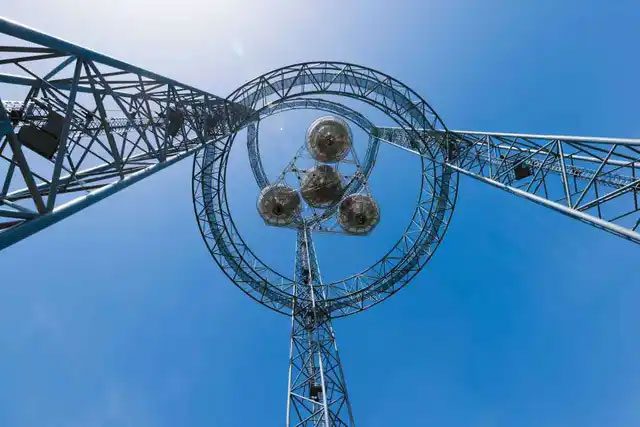Researchers at Xidian University in China have announced the successful completion of a groundbreaking experiment that could pave the way for harvesting solar energy from space and transmitting it back to Earth. If successful, this project could enable China to surpass the United States in the capability to harvest solar energy from space and deliver it to Earth.
On June 5, the researchers at Xidian University successfully tested the world’s first fully integrated solar power station. This facility is a 75-meter tall steel structure located in the southern part of Xidian University. It is integrated with five smaller subsystems to enhance the capability of receiving solar energy from space.

The facility is a 75-meter tall steel structure located in the southern part of Xidian University.
A report from the evaluation team stated: “The results of the project are generally advanced compared to global standards, with key technical indicators such as the integrated opto-mechanical-omega design, wireless microwave transmission efficiency over a distance of 55 meters, beam collection efficiency, and functionality rates in the structural system, such as conversion and antenna performance, assessed at a world-leading level.“
Theoretically, satellites could continuously collect photons of sunlight, converting them into electrical energy using photovoltaic cells, and then transforming that electrical energy into microwaves for wireless transmission to energy collection panels on the surface of the Earth—similar to the structure built at Xidian University.
This concept was initiated in the 1960s by scientist Peter Glaser. Harvesting solar energy from space can overcome many disadvantages of ground-based systems as it can operate continuously without waiting for daylight or being affected by weather conditions. However, the costs of launching satellites and building solar energy collection stations in space, along with technological challenges and safety conditions, have hindered such projects for many years.

OMEGA will collect energy from the sun and convert it into electrical energy to transmit back to Earth.
The new energy collection station built by Xidian University is part of the proposal to harvest solar energy from space by a team known as OMEGA – which stands for Orb-Shape Membrane Energy Gathering Array. Once fully constructed and placed in geostationary orbit, OMEGA will collect energy from the sun and convert it into electrical energy for microwave transmission back to Earth.
The OMEGA project was proposed by Duan Baoyan from the School of Mechanical Engineering at Xidian University and colleagues in 2014. Two years prior, NASA also announced a similar plan called SPS-ALPHA (Solar Power Satellite via Arbitrarily Large Phased Array), which includes a space satellite with multiple smaller components capable of transmitting energy back to Earth. However, the announcement from Xidian University indicates that China is outpacing the United States in the capability of space energy transmission, despite starting two years later.

Transmitting solar energy from space still requires many more generations.
One of the most notable achievements of OMEGA so far is that researchers have successfully transmitted energy wirelessly in the form of microwaves over a distance of 55 meters. This success marks a significant advancement for the future infrastructure of solar energy collection from space. According to a press release, the successful test earlier this month has allowed researchers to advance three years ahead of the project’s timeline.
However, researcher Baoyan also acknowledged that transmitting solar energy from space will still require many more generations.
Nonetheless, this indicates that the concept of solar energy from space remains highly promising, and it could help reduce our dependence on fossil fuels. Building such a complex system is a colossal challenge, but it has the potential to revolutionize how we collect energy.





















































